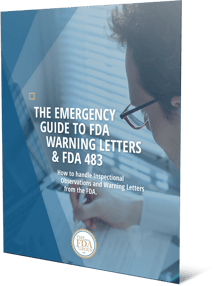FDA Warning Letters are official notices informing manufacturers and other companies they are in violation of the Federal Food, Drug, and Cosmetic (FD&C) Act while providing them with an opportunity to voluntarily correct violations before initiating enforcement action. In the words of the FDA, a Warning Letter:
“...notifies a company that the FDA considers one or more products, processes, practices or other activities to be in violation of the Federal Food, Drug, and Cosmetic Act (the Act), its implementing regulations and other federal statutes.”
If you’ve received a Warning Letter, we’ve compiled everything you need to know about planning and executing a successful recovery in a free white paper: The Emergency Guide to FDA Warning Letters & FDA 483.
Warning Letters are only issued for violations of regulatory significance or those that may actually lead to an enforcement action if the documented violations are not promptly and adequately corrected.
Warning Letters are not private communications. Once one is issued, it’s immediately posted on the FDA website, which can bring a wave of questions and concerns once the news reaches customers, investors, competitors and others.
Read Also: 5 Indirect Costs of an FDA Warning Letter
Unlike an FDA Form 483, Warning Letters can directly affect product submissions, preventing you from reaching international markets and/or lead to seizures, injunctions, and even criminal prosecution. For foreign manufacturers, a Warning Letter can put you on the import hold list, effectively removing your products from the U.S. market entirely.
With such high stakes, it’s important to understand the basic steps of Warning Letter recovery, which we’ve laid out below:
1. Acknowledge you’ve received a Warning Letter.
Through certified mail, inform the FDA you intend to respond to the Warning Letter within 15 business days. This should be a simple correspondence meant only to show you intend to respond by the deadline.
2. Assemble an action team and/or seek experienced outside help.
Once you’ve informed the FDA you intend to resolve the issues, it’s time to decide whether you’ll handle recovery on your own, or seek out an experienced third party for assistance.
If you’re confident you have the right personnel on staff, gather key Quality Assurance, Operations, Compliance and Regulatory Affairs personnel, designating a trusted individual to lead the team. This person must have a comprehensive understanding of the problems cited and a clear idea of how to fix them.
[Read Also:] 3 FDA Warning Letter Trends for 2016
If you have any doubt in your ability to completely solve the problems internally, find an experienced third party firm that has a track record of success. The best firms can supply former FDA experts who can build valuable lines of communication directly within the Agency. If you opt for outside help, the following steps can effectively be managed by consultants who can lead and support you through the process.
If you’ve received an FDA Warning Letter and need assistance from qualified, experienced professionals, contact The FDA Group today.
3. Craft a CAPA Plan.
FDA 483s and FDA Warning Letters both require companies to carefully design a Corrective and Preventative Action (CAPA) Plan to address the problems cited by regulators. Grab our free white paper for a clear and concise step-by-step guide: The Emergency Guide to FDA Warning Letters & FDA 483.
Read Also: 3 Key Elements of a Successful CAPA System
Unlike an FDA Form 483, the stakes are higher when handling a Warning Letter. While failing to satisfy regulators with an FDA 483 response typically risks a Warning Letter, failing to submit an adequate Warning Letter response can bring far more severe enforcement actions which can have extremely detrimental effects on your ability to market your products.
→ Grab our free white paper for a comprehensive guide to writing CAPA Plans and conducting root cause analysis: The Guide to CAPA & Root Cause Analysis in FDA-Regulated Industries
4. Provide the FDA with a timeline estimate for CAPA Plan.
If the issues cited in the Warning Letter require more 15 business days to fully implement, provide the FDA with a detailed timeline actions beyond that timeframe.
Remember to follow through on all deadlines you provide. Regulators will likely be monitoring your progress closely.
5. Meet with the FDA to discuss your plan.
The FDA will work relatively closely with companies to discuss the corrective and preventative actions being planned.
Once they are satisfied your plan is adequate, you will be informed of the date for a follow-up inspection and closeout meeting.
Although you may request to meet with the FDA to discuss your recovery plan, don’t rely on regulators to offer advice or meaningful insight into what you should do. If you’re in need of outside help, contact an experienced third party for remediation assistance.
 Want to learn everything you need to know to properly handle an FDA warning letters? Grab our free white paper, The Emergency Guide to FDA Warning Letters & FDA 483.
Want to learn everything you need to know to properly handle an FDA warning letters? Grab our free white paper, The Emergency Guide to FDA Warning Letters & FDA 483.


